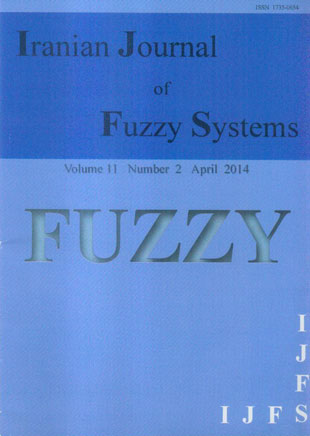فهرست مطالب

Iranian journal of fuzzy systems
Volume:11 Issue: 2, Apr 2014
- 154 صفحه،
- تاریخ انتشار: 1393/02/05
- تعداد عناوین: 10
-
-
صفحه 17
-
صفحه 121
-
Page 1In this paper, we investigate the delay-dependent robust stability of fuzzy Cohen-Grossberg neural networks with Markovian jumping parameter and mixed time varying delays by delay decomposition method. A new Lyapunov-Krasovskii functional (LKF) is constructed by nonuniformly dividing discrete delay interval into multiple subinterval, and choosing proper functionals with different weighting matrices corresponding to different subintervals in the LKFs. A new delay-dependent stability condition is derived with Markovian jumping parameters by T-S fuzzy model. Based on the linear matrix inequality (LMI) technique, maximum admissible upper bound (MAUB) for the discrete and distributed delays are calculated by the LMI Toolbox in MATLAB. Numerical examples are given to illustrate the effectiveness of the proposed method.Keywords: Cohen, Grossberg neural networks, T, S fuzzy, Markovian jumping parameter, Linear matrix inequality, Lyapunov, Krasovskii functional, Maximum admissible upper bound
-
Page 17Applying two definitions of the union of IF-events, P. Grzegorzewski gave two generalizations of the inclusion-exclusion principle for IF-events.In this paper we prove an inclusion-exclusion principle for IF-states based on a method which can also be used to prove Grzegorzewski's inclusion-exclusion principle for probabilities on IF-events.Finally, we give some applications of this principle by extending some results regarding the classical probabilities to the case of the IF-states.Keywords: IF, set, IF, event, IFS, probability, IF, state, Inclusion, exclusion principle, Boole inequality, Bonferroni inequality, L ukasiewicz connectives
-
Page 27The objective of this article is to derive the necessary optimality conditions, known as Pontryagin's minimum principle, for fuzzy optimal control problems based on the concepts of differentiability and integrability of a fuzzy mapping that may be parameterized by the left and right-hand functions of its $alpha$-level sets.Keywords: Fuzzy optimal control problems, Fuzzy Pontryagin's minimum principle, $alpha$, level sets
-
Page 45The purpose of this paper is to develop a methodology for solving a new type of matrix games in which payoffs are expressed with triangular intuitionistic fuzzy numbers (TIFNs). In this methodology, the concept of solutions for matrix games with payoffs of TIFNs is introduced. A pair of auxiliary intuitionistic fuzzy programming models for players are established to determine optimal strategies and the value of the matrix game with payoffs of TIFNs. Based on the cut sets and ranking order relations between TIFNs, the intuitionistic fuzzy programming models are transformed into linear programming models, which are solved using the existing simplex method. Validity and applicability of the proposed methodology are illustrated with a numerical example of the market share problem.Keywords: Interval programming, Intuitionistic fuzzy set, Triangular intuitionistic fuzzy numbers, Matrix game
-
Page 59In this paper, two sets of sufficient conditions are obtained to ensure the existence and stability of a unique equilibrium point of unforced first-order fuzzy relational dynamical systems by using two different approaches which are both based on the fuzzy relational matrix of the model.In the first approach, the equilibrium point of the system is one of the centers of the related membership functions.In the second approach, the equilibrium point of the system is the origin (the center of the middle membership function) and the behavior of the system, though can be nonlinear, is symmetric around the origin.The results are approved by numerical examples.Keywords: Fuzzy relational dynamic system (FRDS), Linguistic stability, Equilibrium point, Fixed, point, Special symmetric matrix, matrices
-
Page 71In this paper we intend to offer new numerical methods to solve the second-order fuzzy Abel-Volterra integro-differential equations under the generalized $H$-differentiability. The existence and uniqueness of the solution and convergence of the proposed methods are proved in details and the efficiency of the methods is illustrated through a numerical example.Keywords: acobi polynomials, Airfoil polynomials, Collocation method, Fuzzy integro, differential equations, Abel, Volterra integral equations, Generalized differentiability
-
Page 89Let $R$ be a commutative ring. We write $mbox{Hom}(mu_A, nu_B)$ for the set of all fuzzy $R$-morphisms from $mu_A$ to $nu_B$, where $mu_A$ and $nu_B$ are two fuzzy $R$-modules. We make$mbox{Hom}(mu_A, nu_B)$ into fuzzy $R$-module by redefining a function $alpha:mbox{Hom}(mu_A, nu_B)longrightarrow [0,1]$. We study the properties of the functor $mbox{Hom}(mu_A,-):FRmbox{-Mod}rightarrow FRmbox{-Mod}$ and get some unexpected results. In addition, we prove that$mbox{Hom}(xi_p,-)$ is exact if and only if $xi_P$ is a fuzzy projective $R$-module, when $R$ is a commutative semiperfect ring.Finally, we investigate tensor product of two fuzzy $R$-modules and get some related properties. Also, we study the relationships between Hom functor and tensor functor.Keywords: Fuzzy set, Hom functor, Fuzzy projective $R$, module, Fuzzy $R$, module, Tensor product, Functor
-
Page 103In this paper, we shall introduce the fuzzy w-distance, then prove a common fixed point theorem with respect to fuzzy w-distance for two mappings under the condition of weakly compatible in complete fuzzy metric spaces.Keywords: Fuzzy w, distance, Fuzzy metric contractive mapping, Complete fuzzy metric space, Common fixed point theorem References
-
Page 113In this paper, we introduce a new concept of fuzzy generalized contraction and give a fixed point result for such mappings in the setting of fuzzy M-complete metric spaces. We also give an affirmative partial answer to a question posed by Wardowski [D. Wardowski, Fuzzy contractive mappings and fixed points in fuzzy metric spaces, Fuzzy Set Syst., {bf 222}(2013), 108-114].Some examples are also given to support our main result.Keywords: Fuzzy metric space, Fuzzy generalized contractive mapping, Fixed point
-
Page 121In the present paper, we study some properties of fuzzy norm of linear operators. At first the bounded inverse theorem on fuzzy normed linear spaces is investigated. Then, we prove Hahn Banach theorem, uniform boundedness theorem and closed graph theorem on fuzzy normed linear spaces. Finally the set of all compact operators on these spaces is studied.Keywords: Fuzzy norm, Fuzzy normed linear space, Fuzzy bounded linear operator

